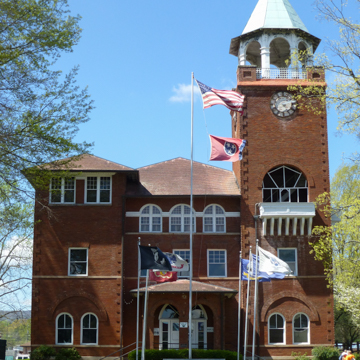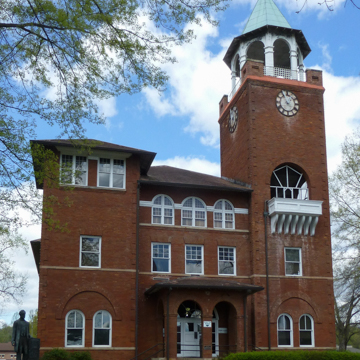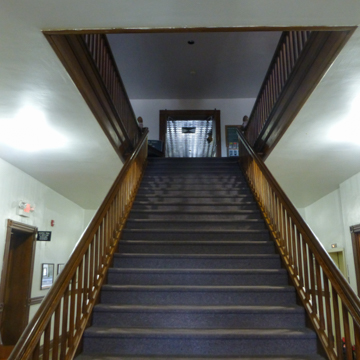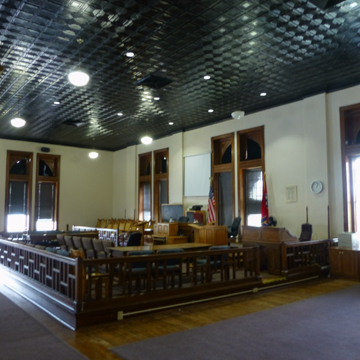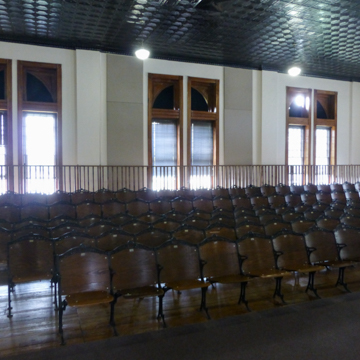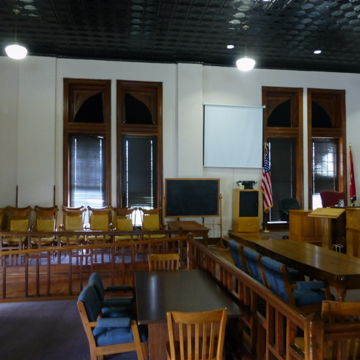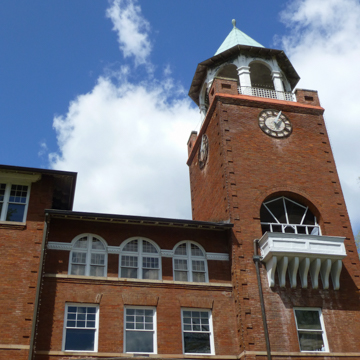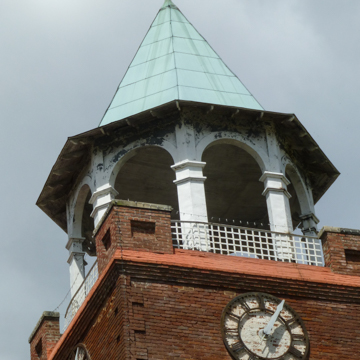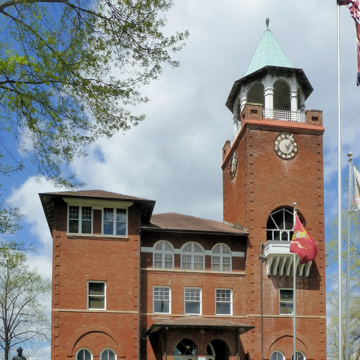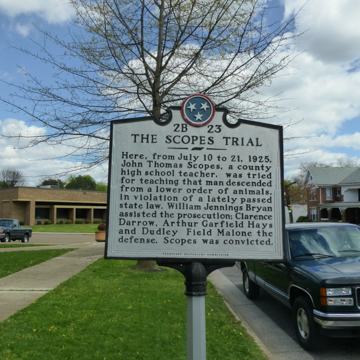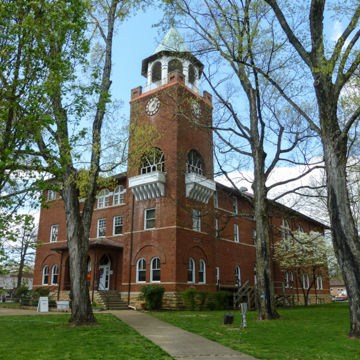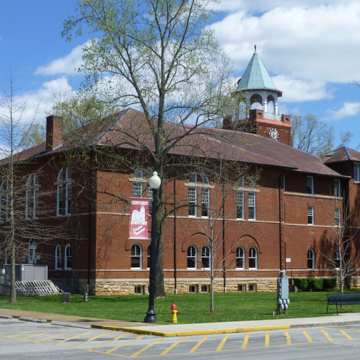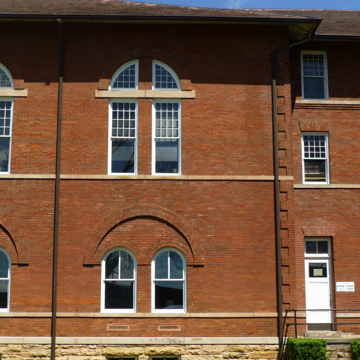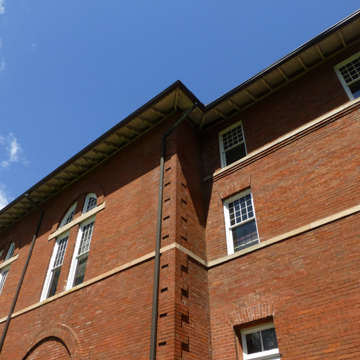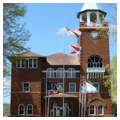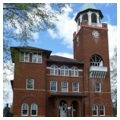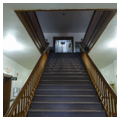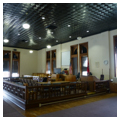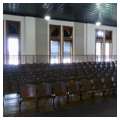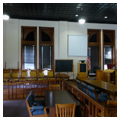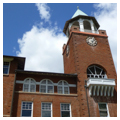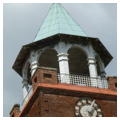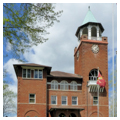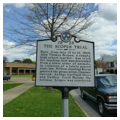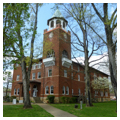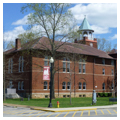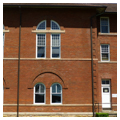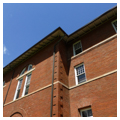Situated on a 300-foot square block in central Dayton, the Rhea County Courthouse was the site of the one of the most famous trials of the twentieth century, the “Scopes Monkey Trial” of 1925. A picturesque building surrounded by willow trees, it is also a remarkably well-preserved work of courthouse architect Walter Chamberlin.
Based in Knoxville, Chamberlin (whose name was often spelled Chamberlain), was active from about 1889 to 1911, and his firm designed no fewer than thirty-nine county courthouses throughout the South, including nine in Tennessee alone. The courthouse for Rhea County was among his earliest, preceded only by his 1889 courthouse for Anderson County in Clinton, Tennessee.
Most of Chamberlin’s courthouses from the 1890s, like the Dayton building, feature a combination of eclectic elements: neoclassical quoins and cupolas on tall central towers, and Romanesque and Renaissance arches around the windows and doors. His designs are frequently characterized by muscular brick pavilions that project from the main body of the structure at the four corners, usually topped with pyramidal roofs. Here, however, a tall tower occupies the southeast corner of the building. In most of his courthouse designs, Chamberlin placed the tower at the center of the principal facade. Here, too, he also shifted the tower composition, placing an open observation platform at the summit, within the cupola and above the clock, rather than below it.
The building has three floors. The first is devoted to offices for county administrators—the clerk, registrar, auditor, and tax assessor—and includes a small chancery courtroom. Upon entering through the front porch, the visitor faces a monumental staircase leading to the second floor and the main courtroom. The two-story courtroom, some 55 feet square, occupies the entire north side of the building, providing seven rows of fixed seats facing a raised podium for the judge, attorneys, witnesses and jury. The original furnishings, including vintage clocks and phones, are all still in place, making it easy to image the atmosphere in the courtroom during the Scopes “monkey” trial, which took place here during a sweltering July 1925.
In March 1925, the Tennessee legislature made it a misdemeanor for any public-school educator to teach “that man descended from a lower order of animals.” That spring, twenty-four-year-old John Thomas Scopes was tried for violating the law. The event drew national attention, especially when the fundamentalist lawyer and former Secretary of State, William Jenning Bryan, took the role as chief prosecutor. Heading the defense was Clarence Darrow, the most celebrated lawyer of his day, whom the American Civil Liberties Union engaged to take the case. The trial took place from July 10 to July 21. Despite the brutal heat, Dayton was overrun by 10,000 daily visitors, many of them journalists like H. L. Mencken who had come to hear the stirring oratory. The trial was popularized by the 1955 play and 1960 movie Inherit the Wind. In the end, Scopes was found guilty and fined $100, though that sentence was overturned by the Tennessee Supreme Court on a technicality. Bryan died five days after the trial and Scopes left Dayton to pursue graduate work in geology at the University of Chicago. In 1967 Tennessee finally repealed the anti-evolution statute.
The first floor of the courthouse is still in use as a Chancery Court but the main courtroom on the second floor is maintained as a national historic landmark. A museum devoted to the Scopes trial and to the history of Rhea County occupies the basement. In 2006, an over-life-sized bronze statue of William Jennings Bryan by Chattanooga sculptor Cessna Decosimo was installed on the front lawn near the entrance. Both the museum and the courthouse are open to the public free of charge.
References
Caldwell, Wilber W. The Courthouse and the Depot: The Architecture of Hope in an Age of Despair: A Narrative Guide to Railroad Expansion and Its Impact on Public Architecture in Georgia, 1833-1910. Macon, GA: Mercer University Press, 2001.
Emrick, Michael. Tennessee Courthouses: A Celebration of 200 Years of County Courthouse. London, KY: John W. Carpenter, 1996.
Mercer, Theodore C., “Rhea County Courthouse” Rhea County, Tennessee. National Register of Historic Places Nomination Form, 1972. National Park Service, U.S. Department of the Interior, Washington, D.C.














